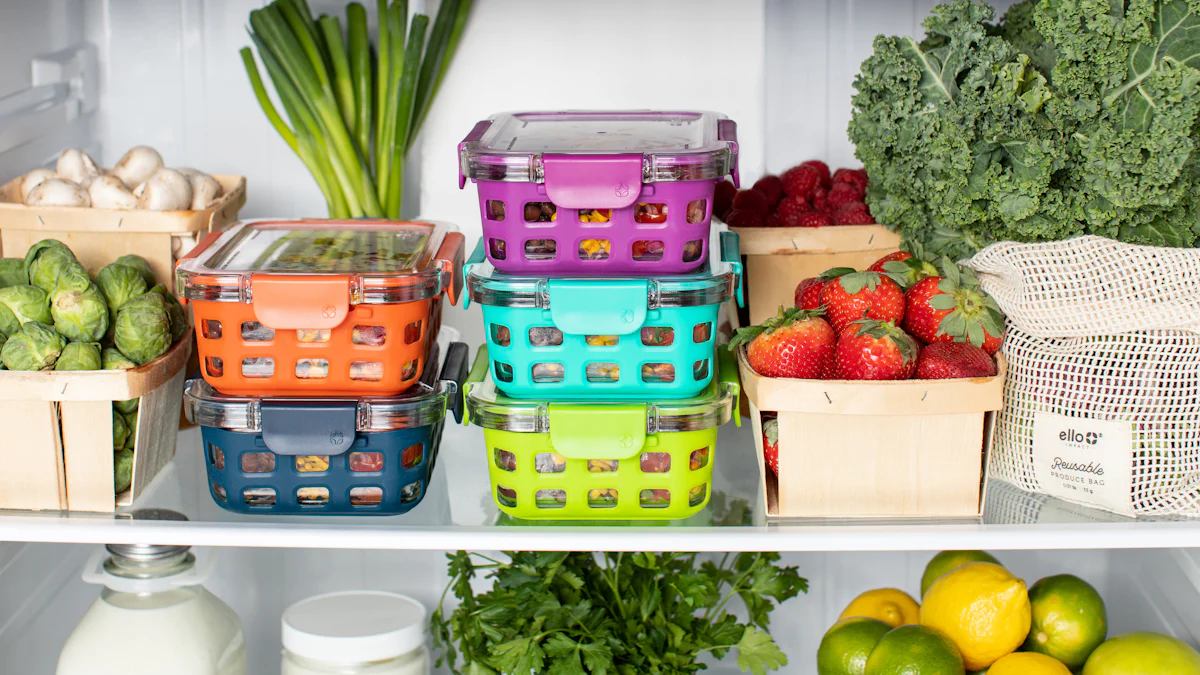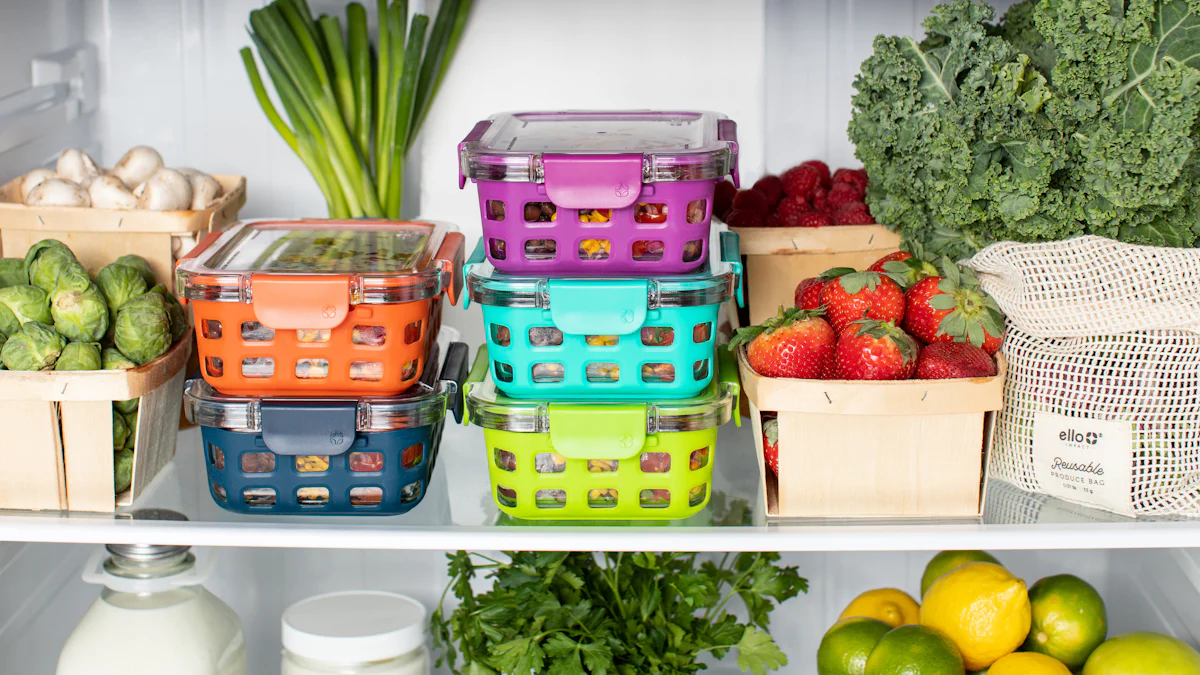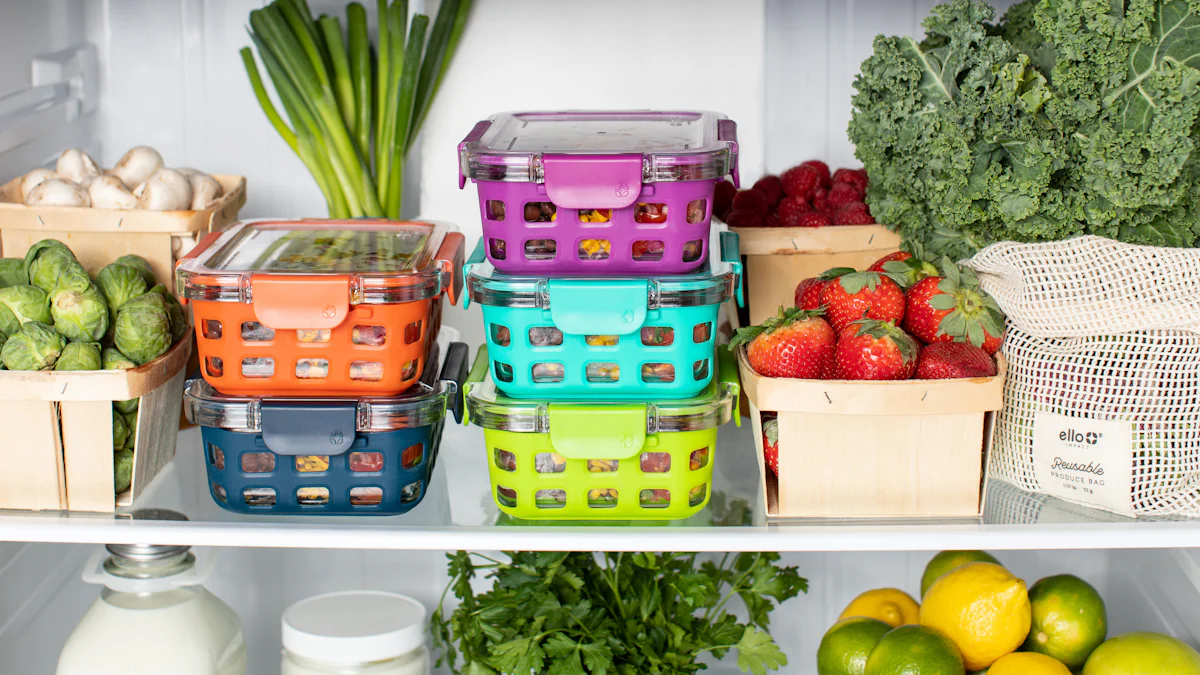
Proper storage of fruits and vegetables is crucial for maintaining their freshness and reducing unnecessary waste. By following effective storage tips, individuals can significantly extend the shelf life of their produce, contributing to a more sustainable approach to food consumption. In this blog, readers will discover valuable insights on temperature control, humidity levels, and suitable storage containers for different types of fruits and vegetables. Implementing these tips from vegetable fruit storage container Freshness Keeper can revolutionize how you store your fresh produce at home.
General Storage Principles
Temperature Control
Maintaining ideal temperatures is crucial for preserving the freshness of various types of produce. Optimum Storage Conditions for Fresh Fruits and Vegetables suggest that low temperatures ranging from 32 to 55°F, along with high relative humidities between 80 to 95 percent, can effectively lower respiration rates and slow down metabolic processes. Different fruits and vegetables have specific temperature requirements that should be carefully considered to ensure their longevity.
To monitor and adjust storage temperatures effectively, it’s essential to use a reliable thermometer in your storage area. This simple tool allows you to track the temperature accurately and make necessary adjustments promptly. By following the guidance from Temperature and Humidity Levels for Different Types of Fruits, you can ensure that stone fruits are kept at room temperature until ripe, after which refrigeration is recommended. Adhering to these specific temperature guidelines will help maintain the quality and freshness of your produce.
Humidity Levels
Understanding the importance of humidity levels in produce storage is key to extending the shelf life of fruits and vegetables. According to Optimal Storage Conditions for Various Fresh Produce, maintaining relative humidity at an optimal level—neither too high nor too low—is critical for preserving different types of produce effectively. High humidity can lead to excess moisture, causing spoilage, while low humidity can result in dehydration and loss of freshness.
To maintain appropriate humidity levels, consider using containers with built-in ventilation or adjustable humidity settings. These specialized containers provide a controlled environment that helps regulate moisture levels around your produce. By following specific recommendations outlined in Storage Recommendations for Different Produce, such as those for peppers, pears, and potatoes, you can prevent chilling injuries and ensure that your fruits and vegetables remain fresh for longer periods.
Storage Containers
Selecting the right containers plays a significant role in prolonging the freshness of your fruits and vegetables. Different types of produce require specific container features to optimize their storage conditions effectively. The Vegetable Fruit Storage Container by Freshness Keeper offers a range of innovative solutions designed to keep your produce fresh and organized.
When choosing storage containers, consider options with features like vents, moisture control mechanisms, or ethylene absorption capabilities. These advanced functionalities help create an environment that preserves the quality of your fruits and vegetables over time. By utilizing proper storage containers tailored to different types of produce, you can enhance their longevity while reducing unnecessary waste.
Specific Storage Tips for Fruits

Berries
Berries are delicate fruits that require special care to maintain their freshness. Unknown, an expert in fruit storage, advises storing them at room temperature in a ventilated container away from other fruits. This method helps prevent premature spoilage and extends the shelf life of your berries. When handling berries, it is crucial to wash them right before eating or storing to prevent moisture buildup, as suggested by Unknown. To ensure those fragile, perishable berries stay fresh for longer, don’t wash them before putting them in the fridge—wait to give them a rinse right before you intend to eat them.
Best practices for storing berries:
- Store berries at room temperature in a ventilated container.
- Wash berries right before eating or storing to prevent moisture buildup.
- Avoid washing berries before refrigerating; rinse just before consumption.
Common mistakes to avoid:
- Storing unwashed berries in the fridge.
- Keeping berries in sealed containers without ventilation.
- Washing all the berries at once instead of individually.
Citrus Fruits
Citrus fruits like oranges and lemons are known for their vibrant flavors and high vitamin C content. Proper storage is essential to preserve their juiciness and freshness over time. When it comes to citrus fruits, ensuring they are stored correctly can make a significant difference in their quality. By following expert advice on citrus fruit storage techniques, you can enjoy these zesty delights at their best.
How to store citrus fruits for maximum freshness:
- Keep citrus fruits loose or in a breathable bag in the refrigerator crisper drawer.
- Store away from high-moisture produce like lettuce or cucumbers.
- Avoid direct sunlight exposure that can lead to dehydration.
Signs of spoilage to watch for:
- Mold growth on the skin of citrus fruits.
- Excessive softness or shriveling of the fruit.
- Unpleasant odor emanating from the fruit.
Apples and Pears
Apples and pears are popular fruits enjoyed for their crisp texture and sweet taste. To maintain these qualities and prevent premature ripening, proper storage conditions are paramount. Understanding how ethylene gas affects apples and pears is key to preserving their freshness while avoiding cross-contamination with other produce items.
Ideal storage conditions for apples and pears:
- Keep apples and pears refrigerated but separate from ethylene-sensitive produce.
- Store apples in perforated plastic bags or open containers with good air circulation.
- Place pears in the refrigerator crisper drawer away from strong-smelling foods.
How to prevent ethylene gas from affecting other produce:
- Store apples separately from vegetables like lettuce or carrots.
- Use vegetable fruit storage container Freshness Keeper’s specialized containers with ethylene absorption features.
- Check stored apples regularly for any signs of overripening or decay.
Specific Storage Tips for Vegetables

Leafy Greens
Leafy greens are highly perishable vegetables that require specific storage techniques to maintain their freshness and crispness. Excess moisture can accelerate the rotting process, making it essential to keep these vegetables unwashed until they are ready for use. To ensure the longevity of leafy greens, consider the following expert advice:
Expert Testimony:
Experts from The New York Times emphasize that excess moisture causes leafy greens to rot faster in the fridge. Because of this, most experts recommend keeping these vegetables unwashed until you’re ready to use them.
How to keep leafy greens fresh and crisp:
- Store unwashed leafy greens in a breathable container.
- Place a paper towel at the bottom of the container to absorb excess moisture.
- Keep leafy greens in the crisper drawer of the refrigerator for optimal freshness.
Best storage methods for different types of greens:
- Lettuce:
- Wrap lettuce heads in a dry paper towel before storing.
- Avoid storing lettuce near fruits that emit ethylene gas.
- Spinach:
- Remove any damaged leaves before storage.
- Store spinach in a perforated plastic bag in the fridge.
Root Vegetables
Root vegetables like carrots, beets, and radishes are known for their earthy flavors and nutritional benefits. Proper storage techniques are crucial to prevent spoilage and extend their shelf life. By following simple guidelines, you can enjoy fresh root vegetables for longer periods.
Proper storage techniques for root vegetables:
- Remove green tops from root vegetables before storing.
- Store root vegetables in a cool, dark place away from direct sunlight.
- Use vegetable fruit storage container Freshness Keeper’s containers with adjustable ventilation settings.
How to extend the shelf life of root vegetables:
- Carrots:
- Trim carrot tops and store them in a plastic bag with damp paper towels.
- Check carrots regularly for any signs of softening or mold growth.
- Potatoes:
- Keep potatoes in a well-ventilated container or mesh bag.
- Store potatoes away from onions and garlic to prevent sprouting.
Cruciferous Vegetables
Cruciferous vegetables such as broccoli, cauliflower, and Brussels sprouts are rich in nutrients and offer numerous health benefits. However, improper storage can lead to quality deterioration and loss of flavor. By following specific storage practices, you can preserve the freshness of cruciferous vegetables effectively.
Best practices for storing cruciferous vegetables:
- Wrap broccoli heads loosely in plastic wrap before refrigerating.
- Store cauliflower florets in an airtight container lined with paper towels.
- Utilize Freshness Keeper’s containers with moisture control features for optimal preservation.
Common storage issues and solutions:
- Cabbage:
- Cut cabbage should be tightly wrapped in plastic wrap before refrigeration.
- Check stored cabbage regularly for any signs of wilting or discoloration.
- Brussels Sprouts:
- Trim stem ends before storing Brussels sprouts in a perforated plastic bag.
- Avoid washing Brussels sprouts until you’re ready to cook them to prevent moisture buildup.
Recap the essential tips learned today to enhance your produce storage skills. Implement these strategies diligently for prolonged freshness and reduced waste. Share your unique storage insights or inquire about any queries to foster a community of knowledgeable food preservers. Let’s embark on a journey towards sustainable and efficient fruit and vegetable storage practices together!
See Also
Post time: Jul-02-2024
